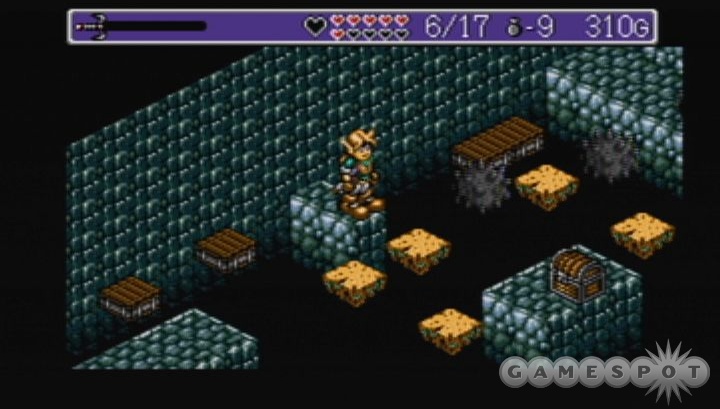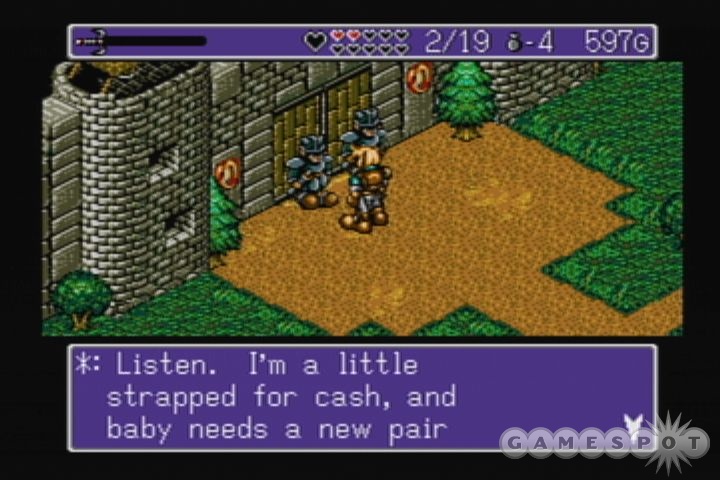In the 16-bit era, the best action adventure games were notable for their sprawling worlds, environmental puzzles, and emphasis on exploration and discovery. Landstalker: The Treasures of King Nole, originally a Sega Genesis game, pulls off these basic action adventure tenets quite well and tops it all off with charming presentation. Unfortunately, it also draws attention away from these perks with its cumbersome controls and frustrating platforming, all of which is exacerbated by an isometric perspective. The result is a lengthy, memorable adventure that, sadly, might be memorable for the wrong reasons for those who are easily flustered.
In Landstalker, you play as Nigel, a pointy-eared treasure hunter who meets a fairy named Friday. When she tells you that she has a hunch on where the fabled treasures of King Nole are, the two of you set off in search of riches. Clever dialogue helps to move the story along. Nigel, Friday, and the various non-player characters often banter with each other, and snide remarks and innuendo abound. The game world is presented in bright, cartoonish colors that pop off the screen, and character sprites are large and detailed. The limited Genesis color palette means that some backgrounds are slightly grainy, but it doesn't destroy the overall charm. The music rounds out the presentation and overshadows the garbled sound effects with upbeat fantasy melodies. The overworld map music is particularly memorable.
The game's isometric perspective gives everything depth, but movement is restricted to the four cardinal directions dictated by that perspective. Imagine the original NES Legend of Zelda turned 45 degrees clockwise: You'll never be able to travel in a straight line to the left or right. If you attempt to do this, Nigel will continue moving on the axis he's facing. This appears to be a concession at first, but in fact can force you to move in undesirable directions. If instead you stopped dead in your tracks, at least you wouldn't fall off of floating platforms.
The platforming elements present another problem. Some locations of interest require you to hop across tiny tiles. At other times, you'll have to avoid floating spike clusters, or climb stairs while dodging cascading boulders. The complete lack of shadows combines with the perspective to make it extremely difficult to tell where you'll land, and where platforms and obstacles lie. The more complex puzzles that involve obstacle navigation become frustrating rather than engaging. Most other puzzles are simple block-pushing affairs that aren't too hard to figure out, so it's a shame that much of the challenge comes from questionable design.
Fortunately, combat doesn't feel clumsy because Nigel cuts swift, wide swaths with his sword. There are few tricks or enemy patterns to learn, so it's easy to keep even the most intimidating monsters at bay. That's not to say that combat is always a cakewalk, particularly when you're surrounded. This is where the controls can get in the way, but more often than not you'll manage to slip away from the cluster so that you can take monsters on in smaller numbers. Considering the navigation issues you'll endure, this in fact turns out to be a good way to let out your frustration, despite the combat's simplicity.
With many of the puzzles being simple and the combat requiring little finesse, much of the challenge comes from all the nooks and crannies to explore. It's easy to miss a few key items and important people because they're well hidden behind bushes or at the end of some out-of-the-way path that you've overlooked. However, these key points aren't so extremely hidden as to cause aggravation. Rarely will you find yourself grumbling, "Well, how was I supposed to find that?" You'll quickly develop a "check everything and talk to everyone" mentality, and this is often enough.

Landstalker is a solid adventure that could have been great. Better controls would've made it more playable and given the developers more leeway to make the puzzles and combat a little more challenging. As it is, though, they're still simple fun, and you'll appreciate the colorful characters and locations that you get to interact with and explore. It's a long journey, with content that lasts more than 15 hours, and is well worth the 800 points. If you can, get used to that control scheme and prepare for frustration; chances are that it'll pay off in the end.
